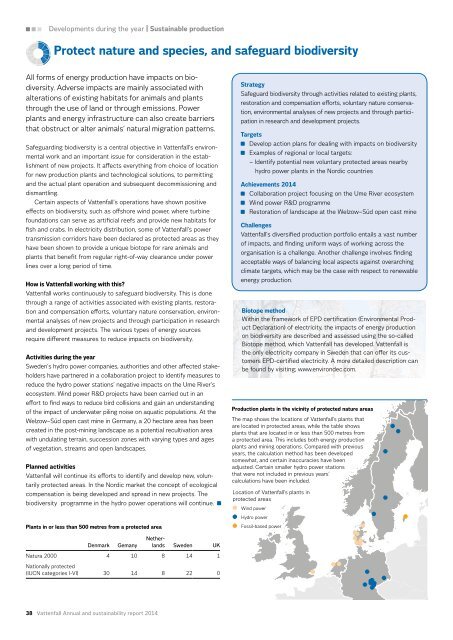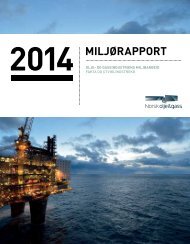annual-and-sustainability-report-2014
annual-and-sustainability-report-2014
annual-and-sustainability-report-2014
You also want an ePaper? Increase the reach of your titles
YUMPU automatically turns print PDFs into web optimized ePapers that Google loves.
Customer solutionsthat enable sustainableuse of energyEnsure<strong>sustainability</strong> inthe supply chainSafeguardthe company’sTransform theproduction portfoliotowards lowerCO 2 emissions<strong>and</strong> morerenewablesIncreasefocus on otheremissionsProtect nature<strong>and</strong> species<strong>and</strong> safeguardbiodiversityImprove resourceefficiencyin Vattenfall’soperationsintegrityTakeresponsibilityEnsure afor Vattenfall‘shealthy <strong>and</strong>impacts on localsafe workplaceOur employees communitiesSustainable consumptionSustainable productionDevelopments during the year | Sustainable productionProtect nature <strong>and</strong> species, <strong>and</strong> safeguard biodiversitySustainable financial performanceAll forms of energy production have impacts on biodiversity.Adverse impacts are mainly associated withalterations of existing habitats for animals <strong>and</strong> plantsthrough the use of l<strong>and</strong> or through emissions. Powerplants <strong>and</strong> energy infrastructure can also create barriersthat obstruct or alter animals’ natural migration patterns.Safeguarding biodiversity is a central objective in Vattenfall’s environmentalwork <strong>and</strong> an important issue for consideration in the establishmentof new projects. It affects everything from choice of locationfor new production plants <strong>and</strong> technological solutions, to permitting<strong>and</strong> the actual plant operation <strong>and</strong> subsequent decommissioning <strong>and</strong>dismantling.Certain aspects of Vattenfall’s operations have shown positiveeffects on biodiversity, such as offshore wind power, where turbinefoundations can serve as artificial reefs <strong>and</strong> provide new habitats forfish <strong>and</strong> crabs. In electricity distribution, some of Vattenfall’s powertransmission corridors have been declared as protected areas as theyhave been shown to provide a unique biotope for rare animals <strong>and</strong>plants that benefit from regular right-of-way clearance under powerlines over a long period of time.How is Vattenfall working with this?Vattenfall works continuously to safeguard biodiversity. This is donethrough a range of activities associated with existing plants, restoration<strong>and</strong> compensation efforts, voluntary nature conservation, environmentalanalyses of new projects <strong>and</strong> through participation in research<strong>and</strong> development projects. The various types of energy sourcesrequire different measures to reduce impacts on biodiversity.Activities during the yearSweden’s hydro power companies, authorities <strong>and</strong> other affected stakeholdershave partnered in a collaboration project to identify measures toreduce the hydro power stations’ negative impacts on the Ume River’secosystem. Wind power R&D projects have been carried out in aneffort to find ways to reduce bird collisions <strong>and</strong> gain an underst<strong>and</strong>ingof the impact of underwater piling noise on aquatic populations. At theWelzow–Süd open cast mine in Germany, a 20 hectare area has beencreated in the post-mining l<strong>and</strong>scape as a potential recultivation areawith undulating terrain, succession zones with varying types <strong>and</strong> agesof vegetation, streams <strong>and</strong> open l<strong>and</strong>scapes.Planned activitiesVattenfall will continue its efforts to identify <strong>and</strong> develop new, voluntarilyprotected areas. In the Nordic market the concept of ecologicalcompensation is being developed <strong>and</strong> spread in new projects. Thebiodiversity programme in the hydro power operations will continue. Plants in or less than 500 metres from a protected areaStrategySafeguard biodiversity through activities related to existing plants,restoration <strong>and</strong> compensation efforts, voluntary nature conservation,environmental analyses of new projects <strong>and</strong> through participationin research <strong>and</strong> development projects.TargetsDevelop action plans for dealing with impacts on biodiversityExamples of regional or local targets:– Identify potential new voluntary protected areas nearbyhydro power plants in the Nordic countriesAchievements <strong>2014</strong>Collaboration project focusing on the Ume River ecosystemWind power R&D programmeRestoration of l<strong>and</strong>scape at the Welzow–Süd open cast mineChallengesVattenfall’s diversified production portfolio entails a vast numberof impacts, <strong>and</strong> finding uniform ways of working across theorganisation is a challenge. Another challenge involves findingacceptable ways of balancing local aspects against overarchingclimate targets, which may be the case with respect to renewableenergy production.Biotope methodWithin the framework of EPD certification (Environmental ProductDeclaration) of electricity, the impacts of energy productionon biodiversity are described <strong>and</strong> assessed using the so-calledBiotope method, which Vattenfall has developed. Vattenfall isthe only electricity company in Sweden that can offer its customersEPD-certified electricity. A more detailed description canbe found by visiting; www.environdec.com.Production plants in the vicinity of protected nature areasThe map shows the locations of Vattenfall’s plants thatare located in protected areas, while the table showsplants that are located in or less than 500 metres froma protected area. This includes both energy productionplants <strong>and</strong> mining operations. Compared with previousyears, the calculation method has been developedsomewhat, <strong>and</strong> certain inaccuracies have beenadjusted. Certain smaller hydro power stationsthat were not included in previous years’calculations have been included.Location of Vattenfall’s plants inprotected areasWind powerHydro powerFossil-based powerDenmarkGemanyNetherl<strong>and</strong>sSweden UKNatura 2000 4 10 8 14 1Nationally protected(IUCN categories I-VI) 30 14 8 22 038 Vattenfall Annual <strong>and</strong> <strong>sustainability</strong> <strong>report</strong> <strong>2014</strong>



